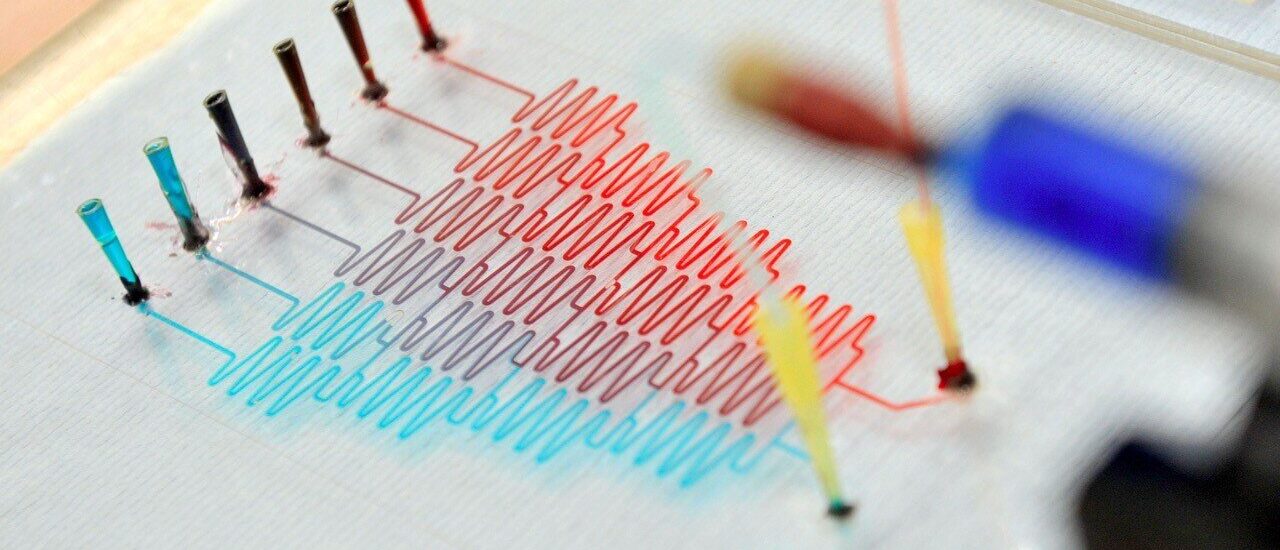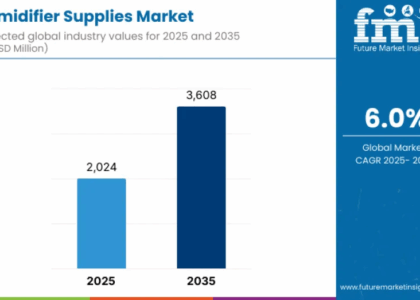The global Microfluidics Market is estimated to be valued at USD 24,647.3 million in 2025 and is projected to reach USD 48,940.0 million by 2035, registering a compound annual growth rate (CAGR) of 7.1% over the forecast period. This growth is driven by the increasing demand for point-of-care (POC) diagnostics, advancements in drug discovery processes, and the rising adoption of lab-on-a-chip technologies.
The microfluidics market is rapidly transforming the landscape of healthcare, diagnostics, pharmaceuticals, and biotechnology. It revolves around the science of manipulating and controlling fluids at a microscale, often in channels less than a millimeter in diameter. Microfluidic technologies enable the miniaturization of laboratory processes, offering faster, more accurate, and cost-efficient results. As industries increasingly embrace this technology, the demand for microfluidic devices continues to grow across various applications such as point-of-care diagnostics, drug delivery systems, and environmental monitoring.
Get Sample Report: – https://www.futuremarketinsights.com/reports/sample/rep-gb-398
The microfluidics market is primarily driven by the growing need for portable and automated devices that can perform complex analytical tasks quickly and with minimal sample volumes. The integration of microfluidic platforms in molecular diagnostics and genomics has opened up new avenues for research and clinical applications. Moreover, the ongoing advancements in microfabrication techniques and material sciences further contribute to the market’s expansion.
Size & Trends
The microfluidics market has been experiencing robust growth due to the increasing adoption of personalized medicine, the surge in chronic disease prevalence, and the growing emphasis on rapid and early disease detection. This upward trend is expected to continue as the demand for high-throughput screening and lab-on-a-chip devices expands across the globe. Researchers and developers are increasingly investing in technologies that can streamline workflows while maintaining accuracy and reproducibility, fueling market momentum.
Key trends influencing the microfluidics market include the rise of organ-on-chip technologies, which mimic human physiological conditions and are revolutionizing drug testing and development. Additionally, the adoption of microfluidic systems in wearable devices and biosensors is gaining traction, particularly in remote healthcare monitoring. These innovations are reshaping the way medical data is collected and analyzed, contributing to a paradigm shift in the healthcare ecosystem.
Key Highlights
One of the most noteworthy highlights of the microfluidics market is its cross-disciplinary nature, merging physics, chemistry, biology, and engineering to create multifunctional platforms. The ability to perform multiple reactions simultaneously on a single chip has become a game-changer in diagnostics and research labs. This has led to increased demand for point-of-care devices, which are now essential in detecting diseases like COVID-19, HIV, and cancer at an early stage.
Another significant highlight is the growing collaboration between academia and industry. Research institutions are working closely with biotech firms and device manufacturers to translate innovative concepts into practical solutions. These partnerships are essential for accelerating time-to-market for new microfluidic-based products. Furthermore, the shift towards environmentally friendly and sustainable materials in device manufacturing reflects a broader industry commitment to green technology.
Challenges and Opportunities
Despite its promising potential, the microfluidics market faces several challenges that hinder its full-scale commercialization. One primary obstacle is the complexity and cost of device fabrication, particularly when transitioning from prototype to mass production. Material compatibility, fluid behavior at micro levels, and device standardization are technical barriers that require ongoing research and development efforts.
However, these challenges present numerous opportunities for innovation. Companies investing in advanced manufacturing techniques such as 3D printing and soft lithography are well-positioned to overcome existing limitations. Additionally, the rising focus on automation and integration with artificial intelligence opens new doors for microfluidics in predictive diagnostics and real-time monitoring. As data analytics and machine learning become integral to healthcare, microfluidic platforms can serve as vital tools for personalized and data-driven care.
Key Benefits for Stakeholders
The microfluidics market offers substantial benefits for stakeholders across the value chain. For healthcare providers and laboratories, microfluidic devices ensure quicker turnaround times, reduced reagent consumption, and minimized human error. This enhances diagnostic accuracy and overall workflow efficiency, particularly in resource-limited settings.
Investors and technology developers gain from the market’s high growth potential and its ability to disrupt conventional methodologies. The shift towards home-based diagnostics and wearable technologies creates lucrative opportunities for entrepreneurs and startups. Meanwhile, patients benefit from the increased accessibility of diagnostic tools, shorter hospital stays, and more personalized treatment plans.
Regulatory bodies also find value in the standardization efforts and quality control that microfluidic technologies support, allowing for more consistent and reliable testing procedures. Collectively, these advantages contribute to an ecosystem where all stakeholders are positioned for sustainable growth.
Market Share by Geographical Region
Geographically, the microfluidics market exhibits strong performance across North America, Europe, Asia-Pacific, and other emerging regions. North America currently leads in terms of market share due to the presence of major industry players, advanced healthcare infrastructure, and substantial investments in R&D. The region’s proactive regulatory environment and emphasis on early disease detection further fuel demand for microfluidic solutions.
Europe follows closely, benefiting from a strong focus on biomedical research and the adoption of innovative diagnostic technologies. Countries like Germany, the UK, and France are at the forefront of integrating microfluidics into academic and clinical research settings. The European market is also supported by various funding initiatives from government and private institutions.
In the Asia-Pacific region, rapid economic development, rising healthcare awareness, and a growing aging population contribute to the market’s expansion. Countries such as China, Japan, South Korea, and India are investing heavily in healthcare infrastructure and biotechnology, making them key contributors to future market growth. Meanwhile, regions in Latin America and the Middle East are gradually adopting microfluidic technologies, driven by increasing healthcare expenditures and technological advancements.
Competitive Outlook
The microfluidics market is characterized by a highly competitive and fragmented landscape, with a mix of established companies, startups, and academic institutions. Players are continuously investing in R&D to develop innovative solutions that address existing limitations and meet emerging demands. Strategic collaborations, mergers, and acquisitions are common, as companies aim to expand their technological capabilities and global presence.
The competition extends beyond traditional medical devices to encompass the broader life sciences and biotechnology domains. Firms are exploring new business models, including subscription-based diagnostic services and integrated hardware-software platforms, to differentiate themselves in the marketplace. Intellectual property and proprietary technologies remain crucial assets, offering a competitive edge to companies that invest heavily in innovation.
Top Companies
Several top companies dominate the microfluidics market by offering a wide array of products tailored for diagnostics, drug development, and academic research. These companies leverage their extensive distribution networks and technological expertise to maintain a competitive position. Their portfolios often include lab-on-a-chip devices, microfluidic cartridges, and custom-built platforms for specific applications.
In addition to large players, many small and medium-sized enterprises (SMEs) contribute to market dynamism by developing niche products and solutions. These firms often focus on specialized applications such as microfluidic cell culture, droplet-based systems, and portable diagnostic tools. Collaboration with universities and research centers enables them to stay at the cutting edge of innovation.
Startups are also playing a pivotal role in shaping the future of microfluidics, particularly in developing cost-effective solutions for underserved markets. Their agility and willingness to experiment with novel materials and fabrication techniques provide them with unique opportunities for growth and market penetration.
Explore In-Depth Analysis-Click Here to Access the Report:- https://www.futuremarketinsights.com/reports/microfluidics-market
Segmentation Outlook
The microfluidics market is segmented based on application, material, and end-user. By application, the market spans diagnostics, drug delivery, genomics, proteomics, and environmental monitoring. Diagnostics remains the dominant segment due to the rising demand for rapid and point-of-care testing solutions. Drug delivery systems, particularly in oncology and chronic disease management, are also gaining traction.
Material-wise, the market includes polymers, glass, silicon, and other specialized substrates. Polymers are the most widely used materials due to their affordability, flexibility, and ease of mass production. However, glass and silicon offer higher chemical resistance and are often preferred in applications requiring high precision.
In terms of end-users, the market serves hospitals, academic institutions, diagnostic laboratories, and pharmaceutical companies. Each of these sectors utilizes microfluidic technology for different purposes, ranging from basic research to clinical implementation. The growing integration of microfluidics into wearable medical devices and home diagnostics is also creating new user segments.
About Future Market Insights (FMI)
Future Market Insights, Inc. (ESOMAR certified, recipient of the Stevie Award, and a member of the Greater New York Chamber of Commerce) offers profound insights into the driving factors that are boosting demand in the market. FMI stands as the leading global provider of market intelligence, advisory services, consulting, and events for the Packaging, Food and Beverage, Consumer Technology, Healthcare, Industrial, and Chemicals markets. With a vast team of over 400 analysts worldwide, FMI provides global, regional, and local expertise on diverse domains and industry trends across more than 110 countries.
Contact Us:
Future Market Insights Inc.
Christiana Corporate, 200 Continental Drive,
Suite 401, Newark, Delaware – 19713, USA
T: +1-347-918-3531
For Sales Enquiries: sales@futuremarketinsights.com
Website: https://www.futuremarketinsights.com
LinkedIn| Twitter| Blogs | YouTube






